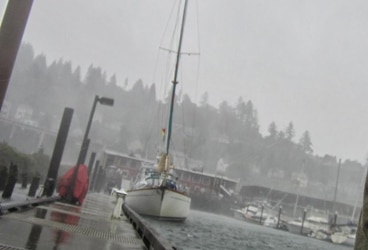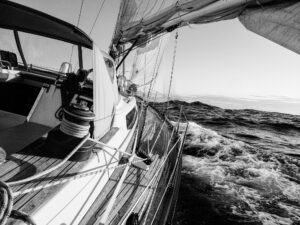
When running, the distance from the point of attachment on the boom to the forward cleat and back aft to a cockpit winch is about 47 feet. We used a 3/8-inch diameter polyester double-braid. Yesterday at the dock, I did my best to measure and it appears the line would have had to stretch at least seven feet to accommodate the aft movement of the boom. That distance is well within the 12-18% stretch that can be expected from this line, but because we had the line winched tightly in the cockpit, it seems some of that stretch should already have been used up. I’m surprised the line didn’t break before it stretched so much further that it allowed the boom to travel across the boat.
But the line didn’t break, the bow cleat held, the standing rigging didn’t part, and the snatch block didn’t explode. The boom bent (and I assume the boom bent at the end of the event, when it crashed to halt on the other side of the boat).
At least at the start of the jibe, there must have been tremendous resistance exerted by the preventer. What’s surprising to me is that none of that resistance seemed evident; when the main back-winded, the boom took off like it was unbridled. After the jibe, the preventer line was extremely tight, pulled across and causing significant deflection in the now-windward shrouds.
While I welcome any advice regarding the appropriate line to use as a preventer on this boat, I suspect our set up was fine, we just had too much sail up. In other words, lower-stretch line may have been more effective at preventing in this situation—or it may have resulted in failure elsewhere, perhaps because it wouldn’t absorb enough of the shock-load produced at the moment the sail fills from the other side—or maybe preventing the boom from crossing the cockpit in the event of a jibe is paramount and if stretch is what allowed our preventer to fail, low-stretch line would have been the way to go—but I think the over-riding point is that we should have been reefed.
Corresponding to the advice from Evan and others, I’ve abandoned my original plan to address this fix entirely in Mexico. While I think a robust fix could be made there, the fix would likely be unsightly and affect the resale value of the boat. And while I’d imagined a fix involving welding, San Diego rigger Stephen Mann pointed out that TIG or MIG welding aluminum weakens the metal.
So before we escape Southern California, I intend to fix this. I called Lefiell Manufacturing in L.A. about a repair, but decided to instead try to replace our bent boom with a used spar. Minney’s in Newport Beach has some—and the prices are right—but the closest example to mine is very over-sized. Then I reached K.C. at Pacific Offshore Rigging in San Diego. They have a consignment boom that will probably work very well and they have the skills and tooling to effect a quick R&R with my hardware. I’m expecting the cost to be about $800 and for us to be in and out of there in about 72 hours.
So we’re on our way to San Diego, then Ensenada, and then La Paz, where the weather is fine, the anchorage is free, the beer is cheap, and the food is to die for.
–MR
In our twenties, we traded our boat for a house and our freedom for careers. In our thirties, we slumbered through the American dream. In our forties, we woke and traded our house for a boat and our careers for freedom. And here we are. Follow along at http://www.logofdelviento.blogspot.com/








